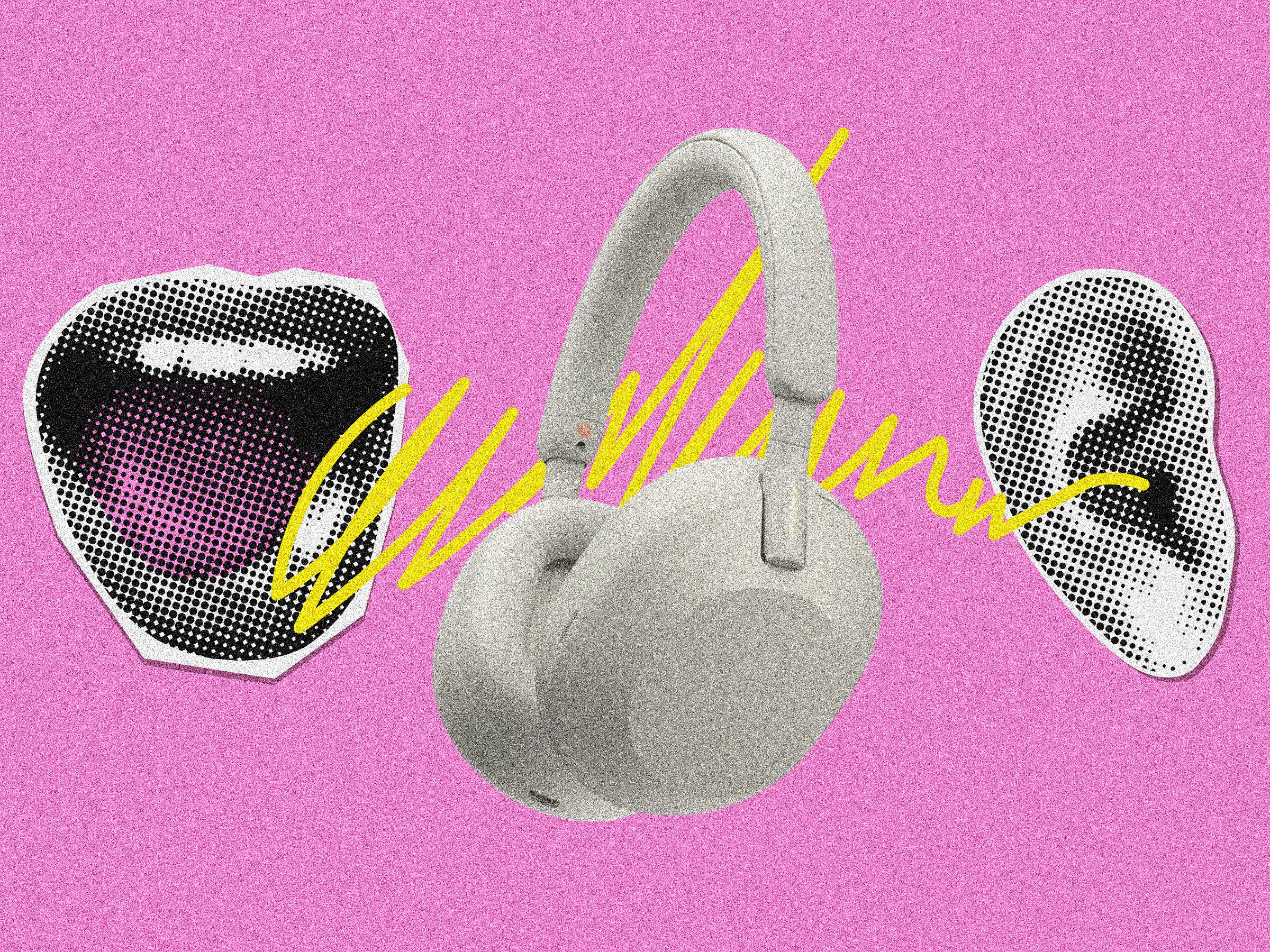For over a decade, Sony has been taking direct aim at Bose’s noise-cancelling domination. Every year or two, Japan’s best and brightest engineers revise its flagship WH-1000 noise-canceling over-ears to beat out whatever the folks in Boston have cooked up, to great effect. The battle has led to some of the best headphones in history, with one or both brands topping our list of the best wireless headphones in nearly endless succession.
Photograph: Parker Hall
With Sony’s new WH-1000XM6 (“1000X mark six”), we’re now half a dozen iterations into a pair that began life as a good pair of headphones. This new version uses that experience to create something astonishing. You get a dramatically refined sound signature and streamlined design, you get 12 microphones and, Sony claims, seven times the processing speed of the previous model (9/10, WIRED Recommends). It’s enough to have even the famously superlative-averse brand calling the noise canceling offered by the WH-1000XM6—accurately, in my experience—the best noise canceling headphones on Earth.
If you are shopping for a pair of premium over-ears for work, travel, or just to escape your neighbor’s annoying dog while you watch Netflix, these are probably the best all-around wireless headphones on sale right now. They cost $50 more at launch than their predecessors, but they’re more than worth the extra cash.
Recent Revisions
Photograph: Parker Hall
There are two distinct eras of Sony’s WH-1000 line visually, with the latest starting with a refined, streamlined look in the WH-1000XM5—abandoning the more businesslike Bose design it used for generations 1-4.
Visually, the latest version is even prettier than the model that came before, with clever folding earcups that help them fit more easily inside a streamlined hard case that now uses a magnetic clasp instead of a zipper.
It’s a sleek hard-shell protector that comes with a clever pocket inside for cables and adapters like most high-end headphones offer these days. A slightly protruding clasp at the edge of the case keeps it from ever tumbling open.
On the headphones themselves, it’s all about subtlety. Even the Sony logo is somewhat hidden on the side of the headband, rather than prominently featuring on an earcup like you’d see in most headphones in this price range—heck, Focal even goes so far as to put a light behind its logo so folks know how fancy you are.
There isn’t much in the way of visible controls either; you’ll find a power button on the bottom of the left earcup, with a button that adjusts the noise-canceling setting that’s a different shape (for easily remembering which is which) above it. On the bottom of the left earcup you’ll find a 3.5 mm port for wired listening. The USB-C charging port is on the bottom right.
As usual, the majority of the playback controls come in the form of touch controls on the right earcup, where you can swipe back and forth to change songs, tap to play and pause, and swipe up or down to adjust volume. Most touch-based controls are woeful when compared to clever physical counterparts like the cool bezel you’ll find on Apple’s AirPods Max (8/10, WIRED Recommends), but these are the best in the business. In multiple days of testing I didn’t have the usual misfires and mishaps that often come with a system that lacks physical feedback. I have a theory that Sony simply makes its touch pad larger than competitors in the space, thus allowing more flexibility in use, but I have yet to pry one of these very much non-replaceable earcups open to see if I’m right.
Photograph: Parker Hall
Speaking of: At first, I was convinced that the new pleather earpads weren’t replaceable. They are, they just latch a bit below where you think they might inside the earcups with plastic tabs, providing the clean look you see on from the outside of the headphones. It’s clever, and it likely works to help provide even better passive noise isolation.
The earpads aren’t the most comfortable things in the world, especially when compared to higher-end offerings like the Focal Bathys MG (9/10, WIRED Recommends), which come with such fine leather you’d imagine it being sewn into King Charles’ dress shoes. These are somewhat cheap-feeling and rubbery faux leather, but they do have very comfortable memory foam that ensures a soft seal around your ears. The non-leather is a good choice for durability, and is shockingly resistant to sweat, which I found out while spreading a fresh layer of mulch around my raspberries.
The headband, however, does leave a bit to be desired. I found it to be a bit uncomfortable after a few hours of solid listening, which is something I can’t say about the previous model. Maybe it’s a head-shape thing, but I feel there could be a bit more padding.
Silencio
Photograph: Parker Hall
The eight microphones on the outside of the two earcups and four inside the earcups do an excellent job of parsing what is going on in the outside world, and when paired with the increased processing power of the WH-1000XM6, they create a staggering level of silence. I was routinely terrified by my wife or dog sneaking up on me while at work, and things like my riding lawn mower and HVAC system were rendered mute.
The increased speediness of the processing is particularly noticeable in the high end, where the fast frequencies are harder to tame than lower, slower sounds. Even my bright and clicky mechanical keyboard was hardly a match for the WH-1000XM6. You can hear them with nothing playing, but the noise disappears as soon as even the lightest music or podcast starts playing.
I didn’t have time to take these on a flight during my short review period, but I did play hours of plane and HVAC noises at real-world decibels through my studio monitors while listening to music on them, and they proved to be more capable than any headphones I’ve ever tested in dealing with those sounds. It’s almost shocking how well they do with a low hum like that of a robovac—I kept accidentally bumping into the moving puck on my floor when wandering around the house with these on, forgetting it was active at all.
Hearthrough functionality is extremely lifelike, which makes these great for putting on music at low volumes and still hearing what’s going on around you. Likewise, call quality from the microphones, and especially the ability to isolate your voice amidst a dense background, is great. The work great on Zoom calls.
Better Sound
Photograph: Parker Hall
Sound quality is something I never fell fully head over heels in love with in previous generations of the WH-1000X, but these come closest to my platonic ideal of studio-style flatness with a tinge of high and low end boost to add a bit more fun to more tepid mixes. I have been enjoying the slurry lo-fi vibes of BRONCHO’s latest record, particularly the song “Dreamin,” on these headphones. I still have essentially no idea what half of the words—which are definitely in English, the language I speak—are thanks to the layered vocal mixing and delivery, but I love the way the acoustic guitars come through at the edges, and the punchy kick drum in the very center of the stereo image.
Everything feels accurate, but there is a certain joy to the musical reproduction coming from the redesigned dynamic drivers inside these headphones that I was missing on older Sony headphones. Classics like The Marshall Tucker Band’s “Can’t You See” come through with smooth tape warmth, perfectly layered bass, and a searing, gravely vocal.
The WH-1000XM6 use noise canceling create a perfectly silent musical backdrop with which to enjoy your favorite music. If you shut your eyes you really can go anywhere with no distractions, as long as the volume is up above about one quarter, and you’re not standing dangerously close to a running jet engine. This is the type of total audio separation I could only have dreamed of with the first model.
Sony has spatial audio on board, so you can also use these to great effect with movies while traveling. I thoroughly enjoyed watching a few episodes of Andor season 2 with them—the excellent low end is particularly noticeable on explosions and during other heavy-action effects.
Usable Anywhere
Photograph: Parker Hall
App-based controls let you dial in said spatial effect, and you can also adjust noise canceling, transparency, and equalization settings inside the app—relatively standard fare for any modern headphones.
One unique Sony feature I love is that you can still cup your hand over the right earcup to temporarily pause your media and pipe in outside sound, which is awesome on airplanes when you don’t want to take your headphones off to give a drink order, or to hear an announcement in the airport.
Sony really has made these some of the easiest to use headphones on the market. Pairing is nearly instant, you have multi-point Bluetooth for connecting to your phone and laptop or tablet at the same time, and 30 hours of battery life is more than enough for any journey, especially with quick charging that can give you 3 hours of power in 3 minutes.
The most annoying thing in my testing? It took me a couple tries to get used to folding the headphones the proper way to put them back in the case. You learn the method—place the left earcup pad-side down in the case, then fold it over—pretty quickly, but it’s not as intuitive as you’d think from such a streamlined pair of headphones.
Otherwise? These sound better than the latest Bose model, offer better noise canceling, and are generally better to use. Compared to the equivalently priced AirPods Max, all those things are also true, except that you might be enough of an iOS stan that the AirPods integrate better into your ecosystem. In any case, I’d strongly recommend you check out a pair of Sony’s new flagship headphones before you make a purchasing decision. They’re one of the finest wireless pairs of headphones ever made.



